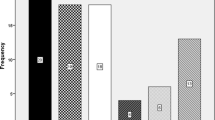Abstract
We describe the steps involved in constructing authors" citation identities (whom they cite) and citation images (who cites them). Familiarity with the intellectual, social, and institutional connections of these authors over time helps inform the analysis and augment the specificity of citation counts. Our study shows that authors" writing and referencing styles constitute a form of watermark for their scholarly output.
Similar content being viewed by others
References
Bazerman, C. (1988), Shaping Written Knowledge: the Genre and Activity of the Experimental Article in Science Madison, WI: University of Wisconsin Press.
Borgman, C. L., Furner, J. (2002), Scholarly communication and bibliometrics. In: Cronin, B. (Ed.), Annual Review of Information Science and Technology, 36, pp. 3-72. Medford, NJ: Information Today Inc./ASIST.
Cronin, B. (1982), Invisible colleges and information transfer: a review and commentary with particular reference to the social sciences, Journal of Documentation, 38 (3): 212-236.
Cronin, B. (1995), The Scholar's Courtesy: the Role of Acknowledgement in the Primary Communication Process London: Taylor Graham.
Cronin, B., Snyder, H., Atkins, H. (1997), Comparative citation rankings of authors in monographic and journal literature: a study of sociology, Journal of Documentation, 53 (3): 263-273.
Davenport, E., Snyder, H. (1995), Who cites women? Whom do women cite?: an exploration of gender and scholarly citation in sociology, Journal of Documentation, 51 (4): 404-410.
David, P. A. (1998), Communication norms and the collective cognitive performance of “invisible colleges.” In: Barba Navaretti, G., Dasgupta, P., Maler, K.-G., Siniscalco, D. (Eds), Creation and Transfer of Knowledge: Institutions and Incentives Berlin: Springer, 115-163.
Geertz, C. (1973), Thick description; toward an interpretative theory of culture. In: The Interpretation of Culture. New York: Basic Books.
Hyland, K. (2000), Disciplinary Discourses: Social Interactions in Academic Writing Harlow: Pearson.
Mendenhall, T. C. (1887), The characteristic curves of composition, Science, IX (214) (Supplement), 237-249.
Moravcsik, M. J. (1988), Citation context classification of a citation classic concerning citation context classification, Social Studies of Science, 18: 515-521.
Moravcsik, M. J., Murugesan, P. (1975), Some results on the function and quality of citations, Social Studies of Science, 5: 86-92.
White, H. D. (2000), Toward ego-centered citation analysis. In: Cronin, B., Atkins, H. B. (Eds), The Web of Knowledge: A Festschrift in Honor of Eugene Garfield Medford, NJ: Information Today, Inc. ASIS Monograph Series, pp. 475-496.
White, H. D. (2001), Authors as citers over time, Journal of the American Society for Information Science and Technology, 52 (2): 87-108.
Author information
Authors and Affiliations
Rights and permissions
About this article
Cite this article
Cronin, B., Shaw, D. Identity-creators and image-makers: Using citation analysis and thick description to put authors in their place. Scientometrics 54, 31–49 (2002). https://doi.org/10.1023/A:1015628320056
Issue Date:
DOI: https://doi.org/10.1023/A:1015628320056




